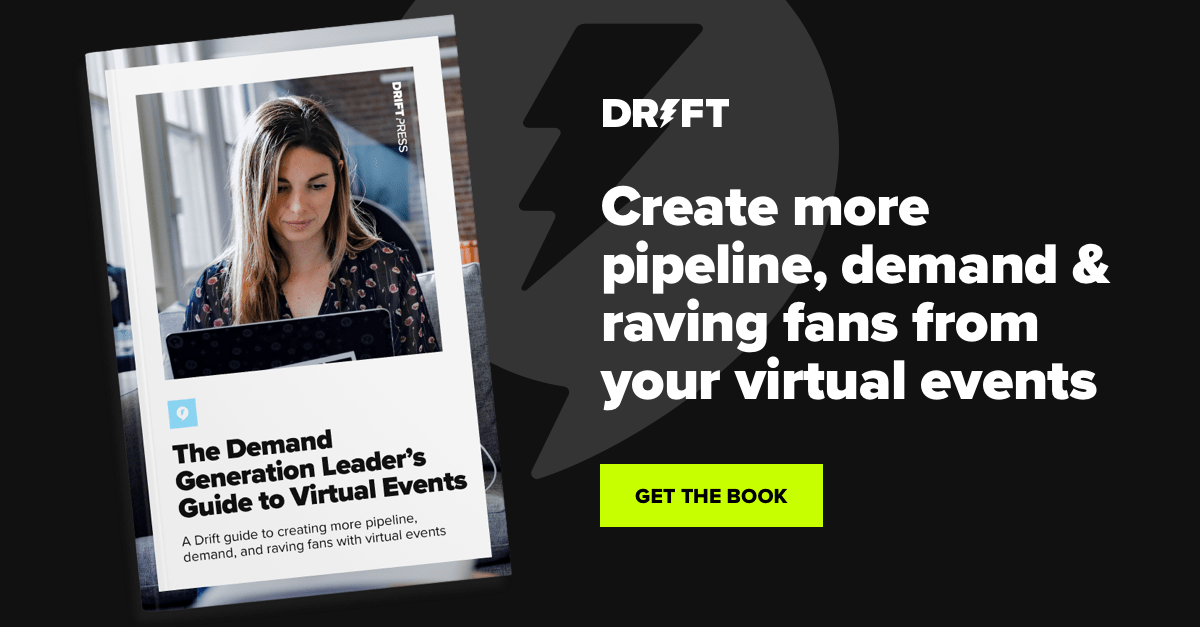Any event manager will tell you: The job doesn’t stop after the conference ends.
The same is true with any virtual event.
Virtual events have real staying power. 93% of marketing leaders plan to continue virtual events in the future. My guess? They’ve seen the long-term revenue impact of virtual events.
Not to mention they:
- Cost less to produce and coordinate
- Access more attendees in more locations
- Provide a data goldmine of event strategies
- Give you an easy way to start (and scale) conversations with target accounts
If events were a top tactic before – 52% of executives say event marketing drives more business value than other marketing channels – they’re definitely a key element of your demand gen strategy now.
If you want to unlock that long-term revenue impact, you have to have a solid post-event strategy in place.
5 Post-Event Tactics to Close More Business
Hear that?
That’s the sigh from hundreds of event managers as they click “End meeting for all.”
Weeks or months of planning, done. But there are a few more things to take care of before you can cross an event off your list. These five post-event tactics make sure your virtual events keep on giving…and giving…and giving.
1. Check Off These 4 Final Logistical Tasks
Now that you can breathe a sigh of relief, it’s time for a few last-minute logistics that make it easier to get more mileage out of your events. Before you get too far into your celebrations:
- Upload recordings and presentations for on-demand viewing.
- Change the language on your event registration page to make it clear the event has already happened, but you can still get the recording and slides.
- Update all of your CTAs and bots elsewhere on your site (like promotional blog posts, etc) to point toward recordings.
- Send a big thank-you to your team! Whether it’s your first event or you’re executing every week, events take a significant amount of cross-functional effort across marketing, sales, and customer support.
Phew! Now comes the fun part: The follow-up.
2. Build the Right Post-Event Nurture Flow
Segment your post-event marketing emails into three buckets: Attendees, registered no-shows, and non-registered subscribers.
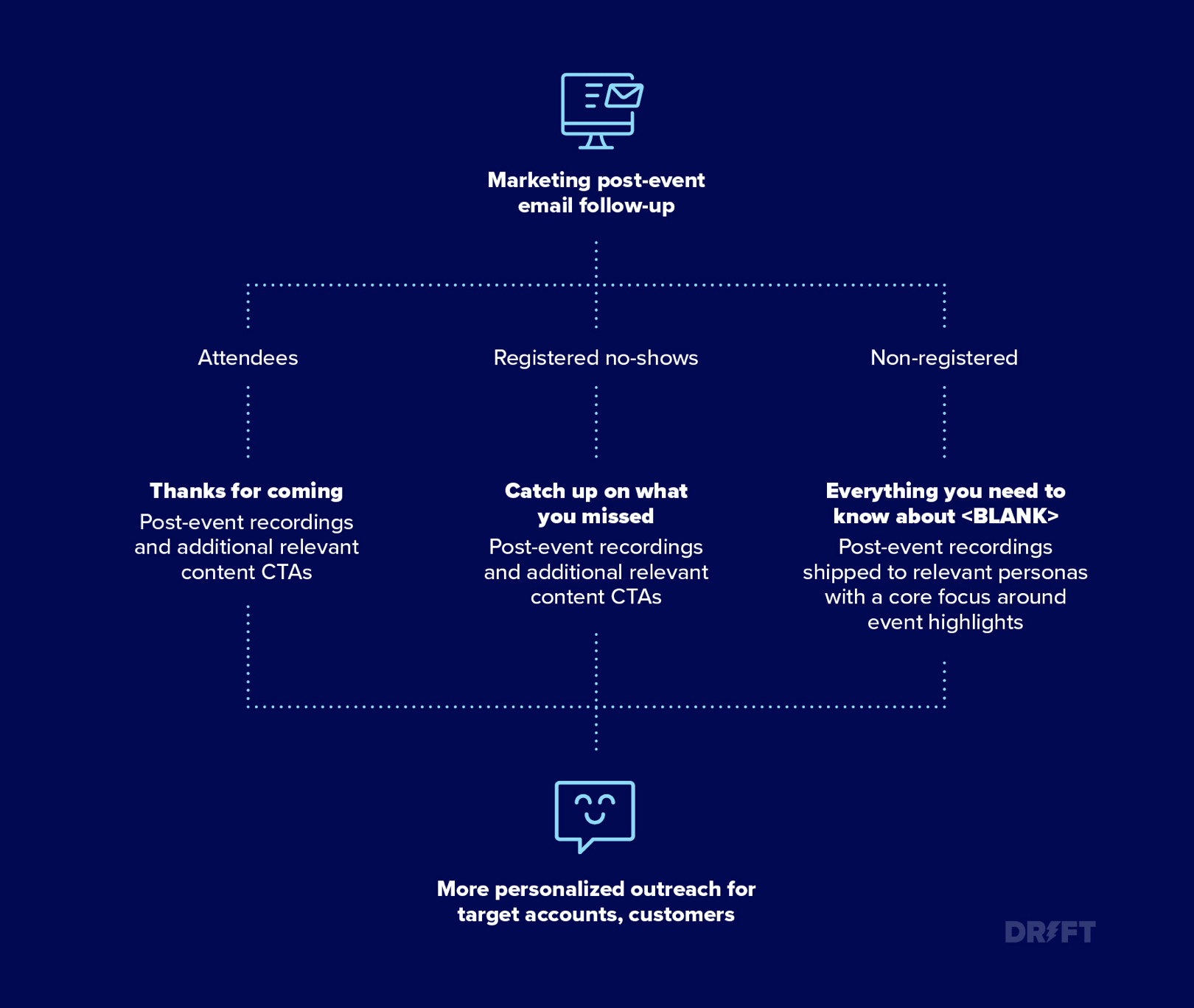
Include your event recording with all three buckets, but package it slightly differently:
- Attendees should receive additional relevant content, especially if it was mentioned during the event. If they’ve already downloaded your suggested offer, include something different. Don’t forget to add a link for attendees to provide feedback or pre-register for something new, too.
- Registered no-shows should feel the FOMO. Give them a link to other relevant content and encourage them to pre-register for the next event so they won’t forget to attend.
- Non-registered subscribers should focus on the core event highlights, plus pre-registration links for your next event. Find out what’s stopping them from attending – whether it’s topical, relevancy, or time.
3. Coordinate Lead Routing for Post-Event Follow Up
Then, it’s time to figure out what to do with all those shiny new leads.
Just send ‘em over to sales, right?
Take it from someone who talks to sales teams every day: That’s not going to help drive post-event revenue. If you flood your sales team with leads that all look the same because they attended your event, they don’t know who to follow up with.
You need to show them the nuance 🔍
Make sure your sales team can actually use them by breaking them down into three tiers:
- High-intent ideal customer profile (ICP) accounts: Personalized and relevant outreach.
- Engaged non-target accounts: Some personalization and outreach.
- Non-ICP or low intent accounts: Add to existing marketing campaigns.
Sales owns #1 and #2. They can develop the right follow-up cadence for those two tiers after the initial send.
But #3…that’s all marketing 🤗 Add those to your existing nurture campaigns where relevant and pull them further down the funnel.
Email isn’t the only way to make those leads work for your team. Your high-intent ICP accounts deserve more of your attention. Whether that’s an email, LinkedIn connection, nurture flow, or a chatbot play, these are the people who are most likely to make a purchase (and attend another event), so make the most of the opportunity. Here’s a helpful breakdown:
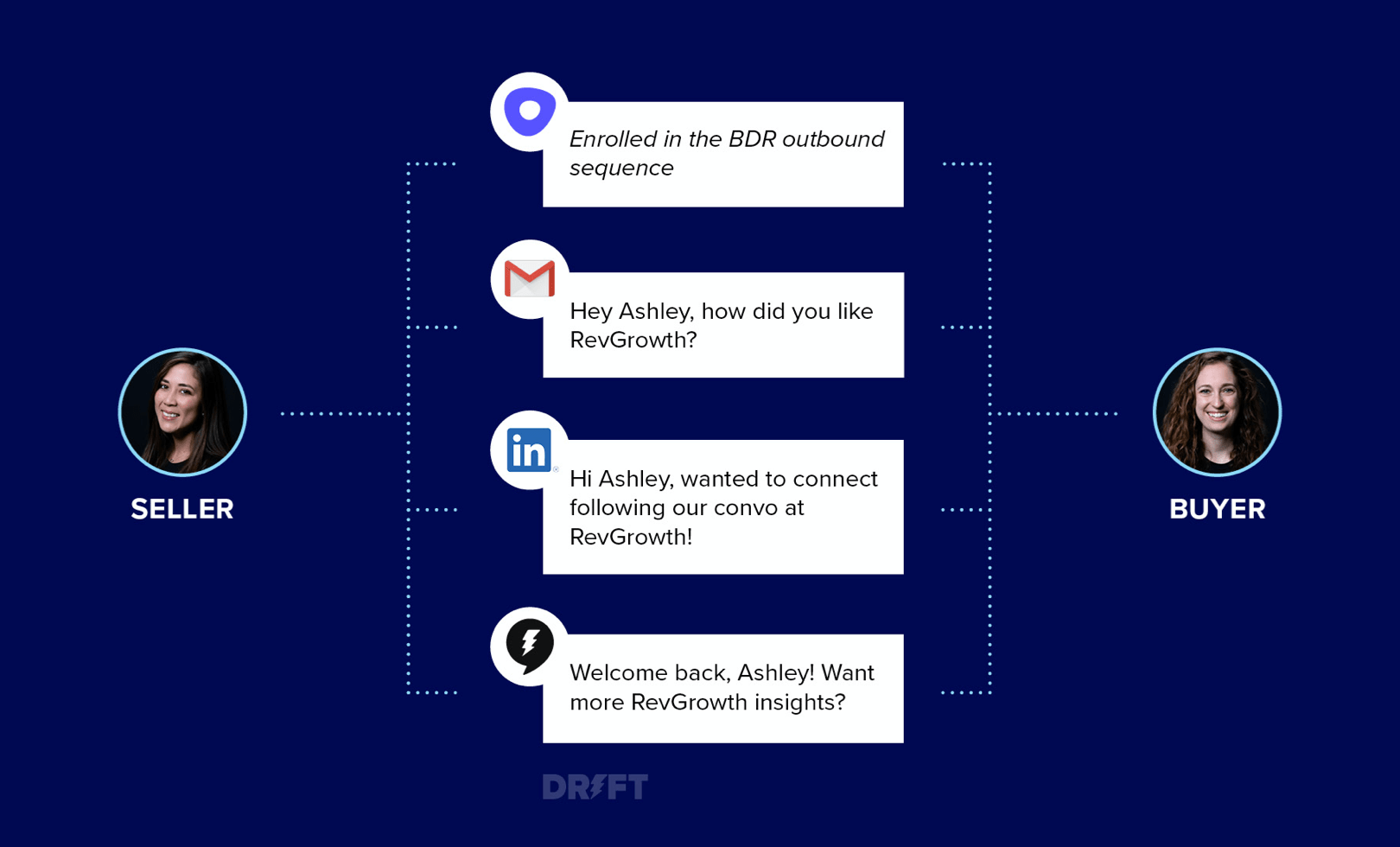
4. Expand Event Content to Drive More Value
Virtual events live on forever.
They’re a content marketer’s dream 😍
But breaking down post-event content can feel overwhelming and hard to scale if you don’t have the right formula.
At Drift, we call it the “solar system” effect. Breaking down larger offers like events into smaller ones looks like this:
- Post all session recordings for on-demand consumption
- Package up series of sessions into online courses and trainings around a topic on Drift Insider
- Turn each session into a blog post
- Create webinar concepts and ideas off of the areas of the event that saw the most engagement
- Repurpose sessions into podcast episodes, or do post-event breakdown podcasts talking through the main points with the speaker
- Make social clips with the best soundbites
Here’s an example of how we did this for our New Funnel for a New Decade virtual summit 👇
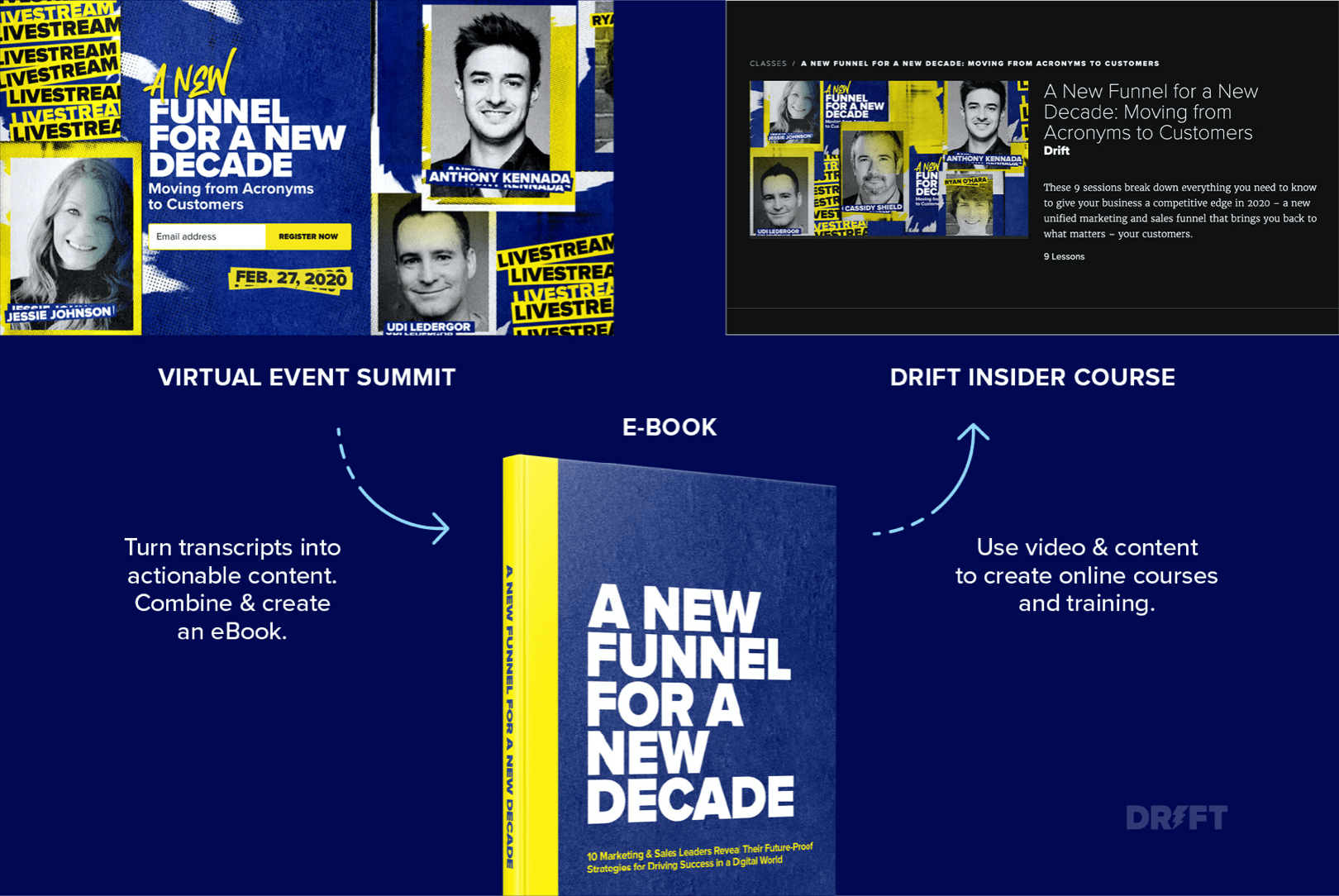
We turned the transcripts of each session into a combined ebook, and then we used the video and content to create corresponding online courses. And then (of course), we took different chapters of the ebook and turned that into blog posts, too.
Sound like a lot of work? Well, it can be. But it’s one of the more easily scalable content plays:
- Transcribe the sessions using a vendor like Rev.
- Identify talented freelancers and provide them with transcriptions, plus an outline and keyword.
- Include a CTA to either the full session recording or other relevant content offers based on the event and target persona.
- Continue the relationship with speakers and ask them to promote content related to their sessions.
The more you can repurpose the content from an event, the more return on your investment you’ll see. And with so much time spent coordinating speakers, topics, and driving registrations, you’ll want to make the most out of any virtual event.
5. Measure the Metrics That Matter
Only 23% of marketers say they can accurately track the ROI of events.
But understanding ROI comes down to your goals and type of event. An all-out two-day summit has very different goals than a 45-minute webinar.
With virtual events, you can access significantly more data – anyone who registers is already in the system, but you can also see overall engagement, how long they attended the sessions, and more.
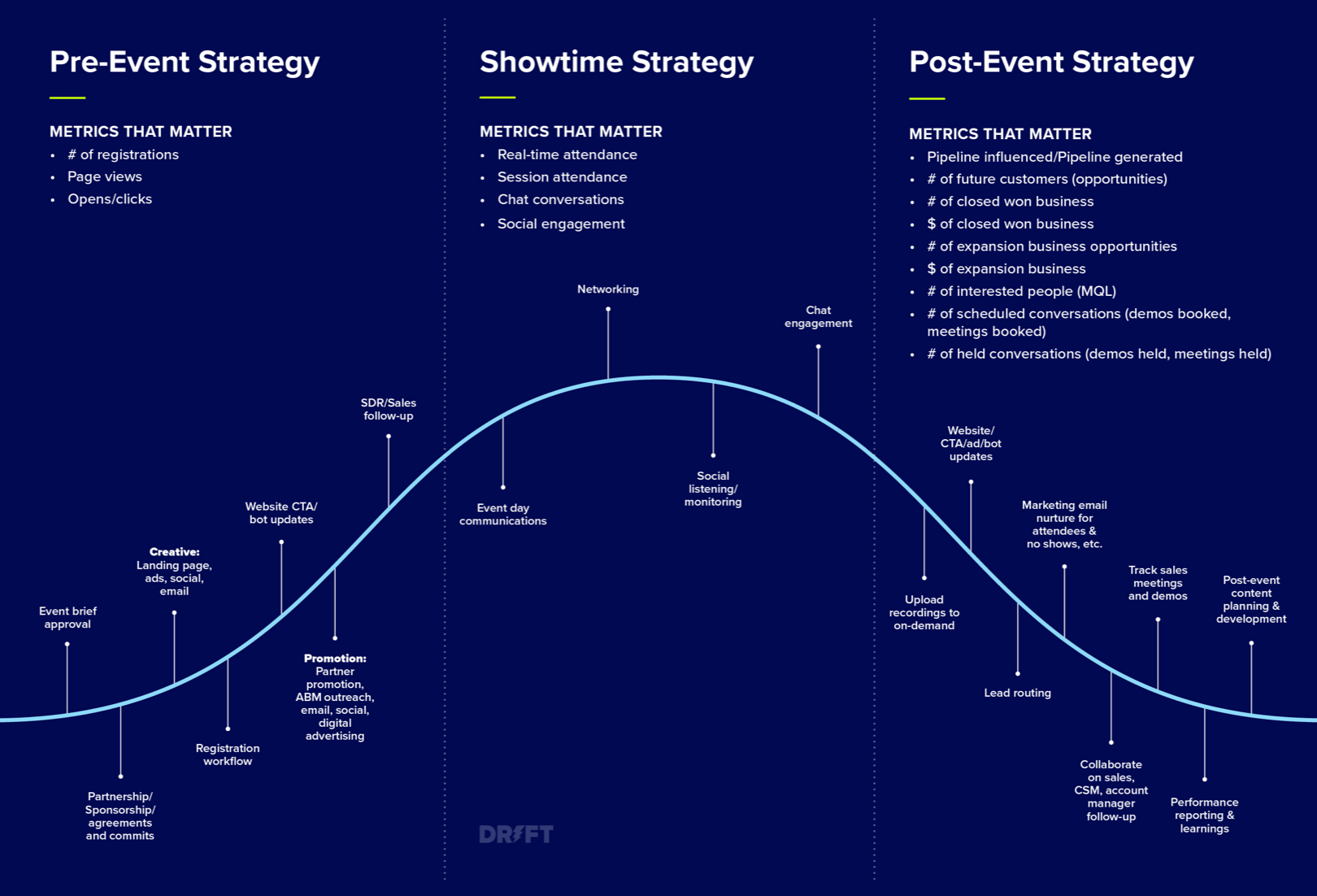
Because most virtual events are free to attend, engagement becomes even more important. Here’s what we track for every virtual event at Drift:
- Pipeline influenced/Pipeline generated
- # of future customers (opportunities)
- # of closed-won business
- $ of closed-won business
- # of expansion business opportunities
- $ of expansion business
- # of interested people (MQL)
- # of scheduled conversations (demos booked, meetings booked)
- # of held conversations (demos held, meetings held)
The dirty secret of event planning is that virtual events require just as much work as in-person ones do.
But with the right post-event strategy – and when you harness the mountains of data that virtual events provide – you might find that virtual events are just the conversion lever your team was missing.





